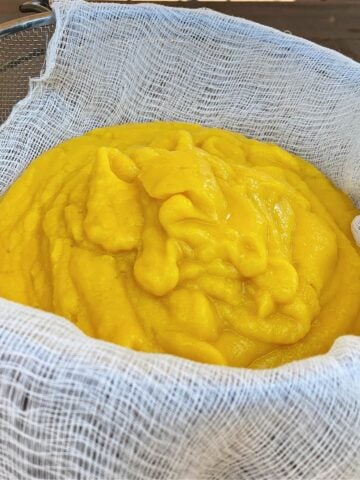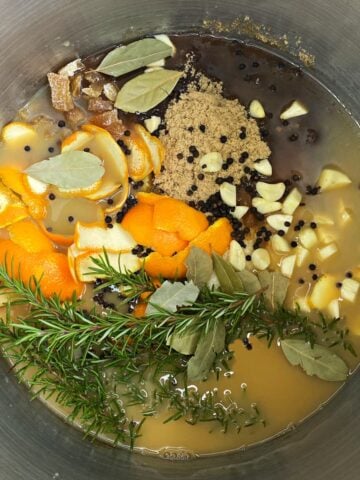Choosing and cutting butternut squash, with its thick skin and dense flesh, can be intimidating. This guide walks you through how to select a perfect butternut squash, then safely peel, cut, and cube it for all your autumn recipe needs.

Jump to:
With a flavor similar to sweet potatoes with undertones of walnut and butterscotch, butternut squash is a delicious addition to all sorts of recipes. Its naturally sweet, nutty flavor adds depth and complexity to soups, salads, sides, and casseroles, and it makes an excellent substitute for pumpkin in nearly any recipe, too.
That said, when it comes to prepping them for cooking, butternut squashes can be a bugger. Their thick skin and dense flesh are difficult to cut, and their elongated pear shape just makes the task even more challenging. It can be intimidating.
Never fear! This guide will walk you through the steps for selecting a perfect butternut squash, and how to cut and cube it for all your autumn recipe needs.
How to Pick a Butternut Squash
Choosing a butternut squash is a lot like choosing a ripe watermelon. To choose the best butternut squashes for your recipes, consider the following points:
- Weight: Like a ripe orange, a butternut squash should feel heavy relative to its size. If it feels light for its size, select a different squash.
- Sound: Give the squash a solid rap on the bulb end: a ripe squash will sound hollow. If you hear a dull thud, move on.
- Stem: A ripe butternut stem will be firm and dry. Avoid squashes with green stems (under-ripe), or soft, moldy stems (over-ripe).
- Skin: Look for squashes creamy tan-colored to dark beige in color, with smooth, thick skin and a matte finish. Avoid shiny squashes (likely under-ripe) or squashes with soft spots, bruises or cuts.
- Shape: Look for squashes with longer necks and smaller bulbs. A smaller bulb means there is a smaller seed cavity and more meat.
How to Cut & Cube Butternut Squash
The best way to cut butternut squash is slowly, and with care.
While not necessary, softening butternut squash before cutting it can make the process a little less intimidating. Start by piercing the whole squash with the tip of a sharp knife and microwaving it for 2-3 minutes. This brief microwaving helps to slightly soften the tough outer skin, making it easier to slice through.
To prepare the butternut squash, first cut off the top and bottom (i.e., the blossom and vine ends).

Cut the squash in half horizontally where the narrower top meets the wider bottom. We have found that the easiest way to do this is by placing the knife on the squash and rolling it slightly under the knife while apply light pressure.

To easily peel butternut squash, use a sharp vegetable peeler or a paring knife.

Cut the bottom of the squash in half and scoop out the seeds.

Once the squash is cut and cleaned, cut it into cubes.

Equipment
To safely cut a butternut squash, you must use a sharp knife. If your knife is dull, take the time to sharpen it first.
My favorite knife for this task is a short, 7-inch chef's knife (sometimes called a housewife's knife). It is long enough to do the job, but not so large that it is unwieldy in the process.
Storage
From the garden: Uncooked, uncut butternut squash will last for up to 6 months when stored in a cool, dry place. Uncooked butternut squash should not be refrigerated. If picked from the garden, butternut squash should be cured with warm temperatures and good air circulation for 10-14 days before storing. (Source: Iowa State Extention)
Refrigerator: Peeled, cubed, or cooked butternut squash can be refrigerated for 5-7 days. Store in an airtight container.
Freezer: Cooked or raw butternut freezes well. To freeze raw cubed squash, place in air-tight freezer bags for up to a year. We recommend vacuum-sealing if that's an option for you.
Top Tip
Did you know that butternut seeds can be roasted just like pumpkin seeds? Clean the seeds, then toss them with a little olive oil, salt and pepper, and roast them on a baking sheet at 325°F (165°C) for about 10 minutes. (Check Top 10 Best Roasted Pumpkin Seed Recipes for more ideas.)

Butternut Squash Recipes

Want More Free Recipes?
Subscribe to our newsletter to get family-friendly recipes and cozy living ideas in your inbox each week!
Find us on Instagram, Pinterest, and Facebook, too.

How to Cube Butternut Squash
Equipment
- 1 7-inch Chefs Knife
- 1 Vegetable Peeler
- 1 large spoon
Ingredients
- 1 whole butternut squash
Instructions
- While not necessary, softening butternut squash before cutting it can make the process a little less intimidating. Start by piercing the whole squash with the tip of a sharp knife and microwaving it for 2-3 minutes. This brief microwaving helps to slightly soften the tough outer skin, making it easier to slice through.
- To prepare the butternut squash, first cut off the top and bottom (i.e., the blossom and vine ends).
- Cut the squash in half horizontally where the narrower top meets the wider bottom. We have found that the easiest way to do this is by placing the knife on the squash and rolling it slightly under the knife while apply light pressure.
- To easily peel butternut squash, use a sharp vegetable peeler or a paring knife.
- Cut the bottom of the squash in half and scoop out the seeds.
- Once the squash is cut and cleaned, cut it into cubes.
Notes
- Weight: Like a ripe orange, a butternut squash should feel heavy relative to its size. If it feels light for its size, select a different squash.
- Sound: Give the squash a solid rap on the bulb end: a ripe squash will sound hollow. If you hear a dull thud, move on.
- Stem: A ripe butternut stem will be firm and dry. Avoid squashes with green stems (under-ripe), or soft, moldy stems (over-ripe).
- Skin: Look for squashes creamy tan-colored to dark beige in color, with smooth, thick skin and a matte finish. Avoid shiny squashes (likely under-ripe) or squashes with soft spots, bruises or cuts.
- Shape: Look for squashes with longer necks and smaller bulbs. A smaller bulb means there is a smaller seed cavity and more meat.
Nutrition
This website provides approximate nutrition information for convenience and as a courtesy only. You are solely responsible for ensuring that any nutritional information provided is accurate, complete, and useful.
Love it? Pin it! If you love these tips for how to cube butternut squash, make sure that you don’t lose it! Pin it to your favorite Pinterest recipe board before you go!

Thank you for visiting the Good Hearted Woman. Remember to bookmark this site, and come back soon!











Leave a Reply